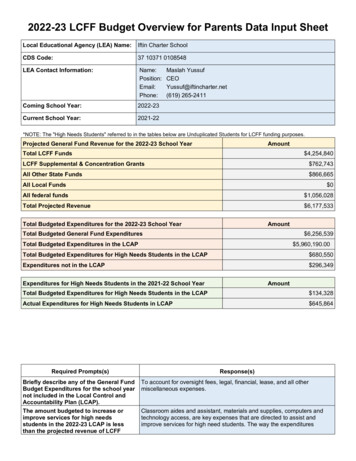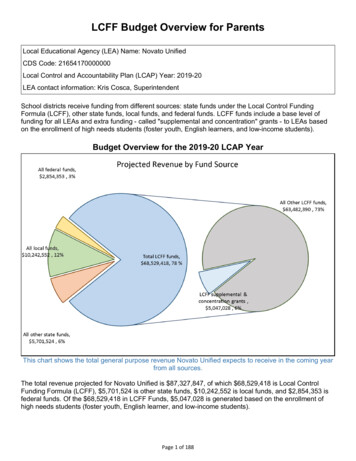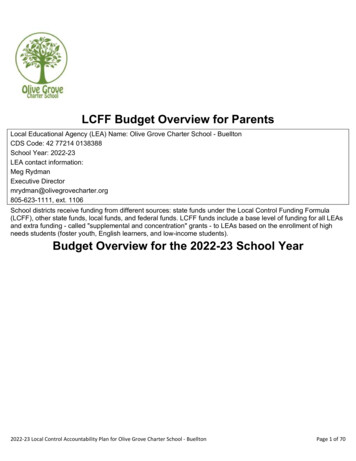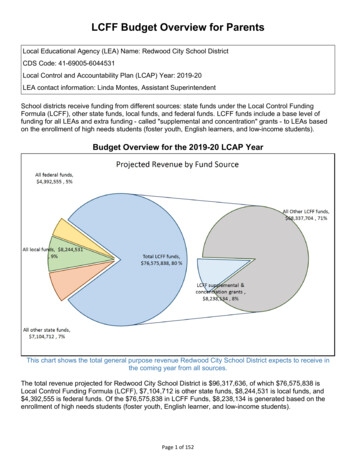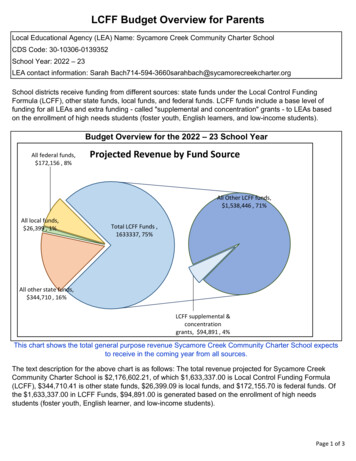
Transcription
LCFF Budget Overview for ParentsLocal Educational Agency (LEA) Name: Sycamore Creek Community Charter SchoolCDS Code: 30-10306-0139352School Year: 2022 – 23LEA contact information: Sarah School districts receive funding from different sources: state funds under the Local Control FundingFormula (LCFF), other state funds, local funds, and federal funds. LCFF funds include a base level offunding for all LEAs and extra funding - called "supplemental and concentration" grants - to LEAs basedon the enrollment of high needs students (foster youth, English learners, and low-income students).Budget Overview for the 2022 – 23 School YearAll federal funds, 172,156 , 8%Projected Revenue by Fund SourceAll Other LCFF funds, 1,538,446 , 71%All local funds, 26,399 , 1%Total LCFF Funds ,1633337, 75%All other state funds, 344,710 , 16%LCFF supplemental &concentrationgrants, 94,891 , 4%This chart shows the total general purpose revenue Sycamore Creek Community Charter School expectsto receive in the coming year from all sources.The text description for the above chart is as follows: The total revenue projected for Sycamore CreekCommunity Charter School is 2,176,602.21, of which 1,633,337.00 is Local Control Funding Formula(LCFF), 344,710.41 is other state funds, 26,399.09 is local funds, and 172,155.70 is federal funds. Ofthe 1,633,337.00 in LCFF Funds, 94,891.00 is generated based on the enrollment of high needsstudents (foster youth, English learner, and low-income students).Page 1 of 3
LCFF Budget Overview for ParentsThe LCFF gives school districts more flexibility in deciding how to use state funds. In exchange, schooldistricts must work with parents, educators, students, and the community to develop a Local Control andAccountability Plan (LCAP) that shows how they will use these funds to serve students.Budgeted Expenditures in the LCAP 2,500,000 2,000,000 1,500,000 1,000,000 500,000Total BudgetedGeneral FundExpenditures, 2,010,760Total BudgetedExpenditures inthe LCAP 1,302,506 0This chart provides a quick summary of how much Sycamore Creek Community Charter School plans tospend for 2022 – 23. It shows how much of the total is tied to planned actions and services in the LCAP.The text description of the above chart is as follows: Sycamore Creek Community Charter School plans tospend 2,010,760.13 for the 2022 – 23 school year. Of that amount, 1,302,506.00 is tied toactions/services in the LCAP and 708,254.13 is not included in the LCAP. The budgeted expendituresthat are not included in the LCAP will be used for the following:Business office expenses, legal and oversight fees, nutrition program, equipment leasesIncreased or Improved Services for High Needs Students in the LCAP for the 2022 – 23School YearIn 2022 – 23, Sycamore Creek Community Charter School is projecting it will receive 94,891.00 basedon the enrollment of foster youth, English learner, and low-income students. Sycamore Creek CommunityCharter School must describe how it intends to increase or improve services for high needs students inthe LCAP. Sycamore Creek Community Charter School plans to spend 124,304.00 towards meeting thisrequirement, as described in the LCAP.Page 2 of 3
LCFF Budget Overview for ParentsUpdate on Increased or Improved Services for High Needs Students in 2021 – 22Prior Year Expenditures: Increased or Improved Services for HighNeeds StudentsTotal Budgeted Expendituresfor High Needs Students in theLCAP 141,667Actual Expenditures for HighNeeds Students in LCAP 122,638 0 20,000 40,000 60,000 80,000 100,000 120,000 140,000 160,000This chart compares what Sycamore Creek Community Charter School budgeted last year in the LCAPfor actions and services that contribute to increasing or improving services for high needs students withwhat Sycamore Creek Community Charter School estimates it has spent on actions and services thatcontribute to increasing or improving services for high needs students in the current year.The text description of the above chart is as follows: In 2021 – 22, Sycamore Creek Community CharterSchool's LCAP budgeted 141,667.00 for planned actions to increase or improve services for high needsstudents. Sycamore Creek Community Charter School actually spent 122,638.00 for actions to increaseor improve services for high needs students in 2021 – 22. The difference between the budgeted andactual expenditures of 19,029.00 had the following impact on Sycamore Creek Community CharterSchool's ability to increase or improve services for high needs students:Students received all services as planned. Pandemic-related funding was used to fund some actions andstaffing shifts resulted in reduced costs in some areas.Page 3 of 3
Supplement to the Annual Update to the 2021–22 Local Control andAccountability PlanLocal Educational Agency (LEA) NameContact Name and TitleEmail and PhoneSycamore Creek Community Charter SchoolSarah Bach, Executive Directorsarahbach@sycamorecreekcharter.org(714) 594-3660California’s 2021–22 Budget Act, the federal American Rescue Plan Act of 2021, and other state and federal relief acts have providedlocal educational agencies (LEAs) with a significant increase in funding to support students, teachers, staff, and their communities inrecovering from the COVID-19 pandemic and to address the impacts of distance learning on students. The following is a one-timemid-year report to the local governing board or body and educational partners related to engagement on, and implementation of, theseActs.A description of how and when the LEA engaged, or plans to engage, its educational partners on the use of funds provided through theBudget Act of 2021 that were not included in the 2021–22 Local Control and Accountability Plan (LCAP).Sycamore Creek Community Charter School did not receive any additional funds through the Budget Act of 2021 that would usuallybe included in the LCAP and were not included in the 2021-22 LCAP.A description of how the LEA used, or plans to use, the additional concentration grant add-on funding it received to increase thenumber of staff who provide direct services to students on school campuses with an enrollment of students who are low-income,English learners, and/or foster youth that is greater than 55 percent.Sycamore Creek Community Charter School did not receive the additional concentration grant add-on funding.A description of how and when the LEA engaged its educational partners on the use of one-time federal funds received that areintended to support recovery from the COVID-19 pandemic and the impacts of distance learning on pupils.Sycamore Creek Community Charter School has an established foundational principle of meaningful educational partnerengagement. These efforts were refined and improved through the Local Control and Accountability Plan (LCAP) developmentprocess. The school’s practices have been further enhanced during the pandemic as Sycamore Creek Community Charter Schoolsought the input and feedback of its educational partner groups from the onset of the pandemic and continuing through thedevelopment of the Learning Continuity and Attendance Plan, the 2021-2022 LCAP, Expanded Learning Opportunities Grant and theESSER III Expenditure Plan.2021–22 LCAP Supplement TemplatePage 1 of 2
The following links and page numbers indicate how and when the LEA engaged its education partners in the use of funds received tosupport recovery for the COVID- 19 Pandemic.LCAP p.41-42 s/2021/07/SCCCS LCAP-2021-2024.pdfExpanded Learning Opportunities Grant Plan x.pdfESSER III Expenditure Plan p. loads/2021/11/SCCCS-ESSER-III-Expenditure-Plan Final approved FINAL.pdfA description of how the LEA is implementing the federal American Rescue Plan Act and federal Elementary and Secondary SchoolEmergency Relief expenditure plan, and the successes and challenges experienced during implementation.Sycamore Creek Community Charter School is successfully implementing efforts to maintain the health and safety of students,educators, and other staff and ensure the continuity of services as required by the federal American Rescue Plan Act. The schoolhas been able to implement clear protocols with regards to daily health reviews, enhanced cleaning, social distancing, and the use ofpersonal protective equipment (PPE) to prevent virus transmission. Students and staff are required to wear face coverings insideexcept while eating. One challenge with implementing the health and safety protocols has been the additional staff time the schoolmust devote to these duties. Continuity of instruction was maintained prior to the Winter Break except for those students who haveneeded to miss school due to illness. After Winter Break, due to the surge in COVID-19 cases, the school returned to onlineinstruction temporarily.Sycamore Creek Community Charter School did receive funds from the American Rescue Plan Act and the Elementary andSecondary School Emergency Relief, but does not plan to spend the funds until the 2022-23 school year, and as such does not haveany expenditure plan or implementation progress to report.A description of how the LEA is using its fiscal resources received for the 2021–22 school year in a manner that is consistent with theapplicable plans and is aligned with the LEA’s 2021–22 LCAP and Annual Update.Sycamore Creek Community Charter School is using the fiscal resources received for the 2021-22 school year with a specific focuson ensuring the academic and social emotional recovery of our students after spending a year or more in a distance learning format.The LCAP prioritizes providing high-quality Waldorf, standards-aligned instruction with specific supports for our highest needstudents. Based on our annual update reflections, the plan addresses learning loss through implementation of assessments and asystem of academic supports provided by classroom teachers and paraprofessionals both within the school day and after school.LCAP p.48-49 s/2021/07/SCCCS LCAP-2021-2024.pdf2021–22 LCAP Supplement TemplatePage 2 of 2
Ensuring our students return to in-person instruction in the safest manner possible, while addressing their social emotional needs isalso prioritized in the LCAP this year (Goal 2, Actions 1-10). LCAP /uploads/2021/07/SCCCS LCAP-2021-2024.pdfInstructions for the Supplement to the Annual Update for the 2021–22 Local Controland Accountability Plan YearFor additional questions or technical assistance related to the completion of the Supplement to the Annual Update to the 2021–22 LocalControl and Accountability Plan (LCAP), please contact the local county office of education (COE), or the California Department ofEducation’s (CDE’s) Local Agency Systems Support Office, by phone at 916-319-0809 or by email at lcff@cde.ca.gov.IntroductionCalifornia’s 2021–22 Budget Act, the federal American Rescue Plan Act of 2021, and other state and federal relief acts have providedlocal educational agencies (LEAs) with a significant increase in funding to support students, teachers, staff, and their communities inrecovering from the COVID-19 pandemic and to address the impacts of distance learning on students. Section 124(e) of Assembly Bill130 requires LEAs to present an update on the Annual Update to the 2021–22 LCAP and Budget Overview for Parents on or beforeFebruary 28, 2022, at a regularly scheduled meeting of the governing board or body of the LEA. At this meeting, the LEA must includeall of the following: The Supplement to the Annual Update for the 2021–22 LCAP (2021–22 Supplement); All available mid-year outcome data related to metrics identified in the 2021–22 LCAP; and Mid-year expenditure and implementation data on all actions identified in the 2021–22 LCAP.When reporting available mid-year outcome, expenditure, and implementation data, LEAs have flexibility to provide this information asbest suits the local context, provided that it is succinct and contains a level of detail that is meaningful and accessible for the LEA’seducational partners.The 2021–22 Supplement is considered part of the 2022–23 LCAP for the purposes of adoption, review, and approval, and must beincluded with the LCAP as follows: The 2022–23 Budget Overview for Parents The 2021–22 Supplement The 2022–23 LCAP2021–22 LCAP Supplement TemplatePage 3 of 2
The Action Tables for the 2022–23 LCAP The Instructions for the LCAP TemplateAs such, the 2021–22 Supplement will be submitted for review and approval as part of the LEA’s 2022–23 LCAP.InstructionsRespond to the following prompts, as required. In responding to these prompts, LEAs must, to the greatest extent practicable, providesuccinct responses that contain a level of detail that will be meaningful and accessible for the LEA’s educational partners and thebroader public and must, to the greatest extent practicable, use language that is understandable and accessible to parents.In responding to these prompts, the LEA has flexibility to reference information provided in other planning documents. An LEA thatchooses to reference information provided in other planning documents must identify the plan(s) being referenced, where the plan(s)are located (such as a link to a web page), and where in the plan the information being referenced may be found.Prompt 1: “A description of how and when the LEA engaged, or plans to engage, its educational partners on the use of funds providedthrough the Budget Act of 2021 that were not included in the 2021–22 Local Control and Accountability Plan (LCAP).”In general, LEAs have flexibility in deciding what funds are included in the LCAP and to what extent those funds are included. If the LEAreceived funding through the Budget Act of 2021 that it would have typically included within its LCAP, identify the funds provided in theBudget Act of 2021 that were not included in the LCAP and provide a description of how the LEA has engaged its educational partnerson the use of funds. If an LEA included the applicable funds in its adopted 2021–22 LCAP, provide this explanation.Prompt 2: “A description of how LEA used, or plans to use, the concentration grant add-on funding it received to increase the numberof staff who provide direct services to students on school campuses with an enrollment of students who are low-income, Englishlearners, and/or foster youth that is greater than 55 percent.”If LEA does not receive a concentration grant or the concentration grant add-on, provide this explanation.Describe how the LEA is using, or plans to use, the concentration grant add-on funds received consistent with California EducationCode Section 42238.02, as amended, to increase the number of certificated staff, classified staff, or both, including custodial staff, whoprovide direct services to students on school campuses with greater than 55 percent unduplicated pupil enrollment, as compared toschools with an enrollment of unduplicated students that is equal to or less than 55 percent.In the event that the additional concentration grant add-on is not sufficient to increase the number of staff providing direct services tostudents at a school with an enrollment of unduplicated students that is greater than 55 percent, describe how the LEA is using the2021–22 LCAP Supplement InstructionsPage 2 of 3
funds to retain staff providing direct services to students at a school with an enrollment of unduplicated students that is greater than 55percent.Prompt 3: “A description of how and when the LEA engaged its educational partners on the use of one-time federal funds received thatare intended to support recovery from the COVID-19 pandemic and the impacts of distance learning on pupils.”If the LEA did not receive one-time federal funding to support recovery from the COVID-19 pandemic and the impacts of distancelearning on students, provide this explanation.Describe how and when the LEA engaged its educational partners on the use of one-time federal funds it received that are intended tosupport recovery from the COVID-19 pandemic and the impacts of distance learning on students. See the COVID-19 Relief FundingSummary Sheet web page (https://www.cde.ca.gov/fg/cr/relieffunds.asp) for a listing of COVID-19 relief funding and the FederalStimulus Funding web page (https://www.cde.ca.gov/fg/cr/) for additional information on these funds. The LEA is not required todescribe engagement that has taken place related to state funds.Prompt 4: “A description of how the LEA is implementing the federal American Rescue Plan Act and federal Elementary andSecondary School Emergency Relief expenditure plan, and the successes and challenges experienced during implementation.”If an LEA does not receive ESSER III funding, provide this explanation.Describe the LEA’s implementation of its efforts to maintain the health and safety of students, educators, and other staff and ensure thecontinuity of services, as required by the federal American Rescue Plan Act of 2021, and its implementation of the federal Elementaryand Secondary School Emergency Relief (ESSER) expenditure plan to date, including successes and challenges.Prompt 5: “A description of how the LEA is using its fiscal resources received for the 2021–22 school year in a manner that isconsistent with the applicable plans and is aligned with the LEA’s 2021–22 LCAP and Annual Update.”Summarize how the LEA is using its fiscal resources received for the 2021–22 school year to implement the requirements of applicableplans in a manner that is aligned with the LEA’s 2021–22 LCAP. For purposes of responding to this prompt, “applicable plans” includethe Safe Return to In-Person Instruction and Continuity of Services Plan and the ESSER III Expenditure Plan.California Department of EducationNovember 20212021–22 LCAP Supplement InstructionsPage 3 of 3
Local Control and Accountability PlanThe instructions for completing the Local Control and Accountability Plan (LCAP) follow the template.Local Educational Agency (LEA) NameContact Name and TitleSycamore Creek Community Charter SchoolDr. Sarah Bach, Executive DirectorEmail and Plan Summary 2022-23General InformationA description of the LEA, its schools, and its students in grades transitional kindergarten–12, as applicable to the LEA.Sycamore Creek Community Charter School (SCCCS), a California nonprofit public benefit corporation with 501(c)(3) tax-exempt statuswhich is currently authorized by the Orange County Board of Education. SCCCS currently serves 127 students in grades TK-7 who benefitfrom small class sizes, an inclusive community, a public Waldorf education, and a focus on the whole child. In the 2021-22 school year,SCCCS had its first class of grade 8, thus becoming a TK-8 Charter School. Parents choose SCCCS for the Waldorf instruction andpersonalized education for their children. SCCCS is committed to being transparent and remaining accountable to its stakeholders.SCCCS will meet the needs of families desiring a Public Waldorf Education recognized by a focus on a “whole-child,” philosophy. SCCCSintends to educate children at the TK-8 level, applying arts-integrated curricula inspired by Waldorf methods, directed by natural,developmental rhythms that enrich student imagination, improve academic performance, and encourage empathetic response to theirenvironment. Teaching emphasizes attention to all intelligence domains. Through experiential, hands-on methods, students will emergecapable of empathetic communication, problem solving, and critical thinking skills with the ability to serve as valuable members of a globalcommunity.Our Mission is to educate students so they:Think critically and independently while recognizing humanity’s interdependence with the local and global community;Strive to control the outcome of their educational goals;Stay committed to engaging the people, places, and learning opportunities around them in order to direct their intellectual, physical, andemotional growth;Value differences in others by responding with empathy; andSee challenges as a natural part of life and an opportunity for growth. SCCCS is filling a community need and meeting the interests of thecommunity. SCCCS has small class sizes with an average student to teacher ratio of 25:1. SCCCS provides interventions to all students whoLocal Control and Accountability Plan TemplatePage 1 of 28
are academically low performing during the school day through daily intervention. SCCCS hosts After School Tutoring. SCCCS providesdeeper extension opportunities to all students who are academically high performing. SCCCS has instituted Positive Behavior Interventionand Supports (PBIS) based on the Waldorf tenets to create a safe setting where students are able to learn, and teachers are able to teach.SCCCS provides technology with a student to device ratio of 1:1 for those who need it, but the Waldorf model is most conducive for studentsto be learning experientially. SCCCS incorporates enrichment opportunities during the school day through broad access to courses. Thesestrategies fill a community need and meet the interest for the community.The Charter School is a diverse, 21st Century School serving 139 TK-8th grade students broken down by student group was as follows: 32(23%) socioeconomically disadvantaged (“SED”) students, 11 (7.9%) English Learners (“ELs”), 3 (2.2%) Reclassified Fluent EnglishProficient (“RFEP”) students, 17 (12.23%) students with disabilities (“SWD”). As of the 2021-22 school year, enrollment by race and ethnicityat SCCCS was 36.7% Latinx, 18% two or more races, 38.1% White, and 4.3% Asian.More specifically, the aforementioned strategies address the needs of students that the Charter School serves. The significant subgroupsthat the Charter School serves are Latinx students, White Students, and SED students. The above strategies that SCCCS utilizes aredesigned to be effective in meeting the needs of all of SCCCS’s students and all of its subgroups. Specifically, the small class size ensuresthat no student’s needs are overlooked. The longer school day ensures that students have more time for instruction, interventions, andenrichment. The social-emotional support for students through SCCCS’s focus on Waldorf ensures that the whole child is supported,especially as to mental health and personal well-being.The purpose of this Local Control Accountability Plan (LCAP) is to address the School Plan for Student Achievement (SPSA) for SCCCSwhich is the Schoolwide Program; herein referred to as the LCAP. The Charter School’s plan is to effectively meet the ESSA Requirements inalignment with the LCAP and other federal, state and local programs. The plans included in the LCAP address these requirements compliantto include focusing on three goals: 1) SCCCS will improve the Distance from Standard (“DFS”) for all students as measured by the SBAC inELA and Math and reported on CA School Dashboard. SCCCS will improve grade level RIT scores for all students in reading and math asmeasured by NWEA MAP; 2) SCCCS will support the social emotional well-being of all students aligned to the tenets of Waldorf andenrichment activities in a safe, inclusive, personalized learning environment which fosters a strong relationship between teachers andstudents; and, 3) SCCCS’s students, parents/guardians, teachers, staff, and community members will be actively engaged in the schoolcommunity as partners in education, communication, and collaboration to provide students with a well-rounded education as evidenced byevents, surveys, and meeting minutes.The Charter School completed a comprehensive needs assessment of the entire school which included an analysis of verifiable localperformance data used to measure student outcomes as evidenced in the annual update portion of the LCAP. The needs assessmentprocess included meeting parents, classified staff, teachers, and students to identify areas of opportunity for the students and groups ofstudents who are not achieving standard mastery and to identify strategies which will be implemented in the LCAP to address those areas ofopportunity.The identification of the process for evaluating and monitoring the implementation of the LCAP and the progress toward accomplishing theestablished goals will include discussing the actions and services with the use of supplemental funds at the school level through the ParentCommunity Council which includes parents of English Learners. The Parent Community Council will meet six times per year to inform theLocal Control and Accountability Plan TemplatePage 2 of 28
process. Parents, classified staff, certificated staff, and an administrator will make up the council. The number of parents will exceed or beequal to the number of total staff members. The council will discuss academic performance, supplemental services, and areas to makeimprovements with Title funds as part of the School Plan included in the LCAP conversations at the meeting in the fall and at the meeting inthe spring. The teachers, staff, students, and parents also participate in an annual survey which provides feedback on the goals andservices. The teachers, staff, and administrators actively participate in the decision making process throughout the year and during LCAPworkshops. The decisions will consider the needs of SCCCS based on student achievement data to include SBAC, ELPAC, NWEA MAP,cumulative assessments, attendance and student demographic data to include the significant subgroups of Latinx students andsocioeconomically disadvantaged students. This student achievement data and student demographic data will be used as a basis for makingdecisions about the use of supplemental federal funds and the development of policies on basic core services.Each goal includes actions and services that address the needs of all students and significant subgroups which include evidence-basedstrategies that provide opportunities for all students, methods and instructional strategies, and particular focus on students at risk of notmeeting the State academic standards.Reflections: SuccessesA description of successes and/or progress based on a review of the California School Dashboard (Dashboard) and local data.Since SCCCS began operation in the Fall of 2019, and the Smarter Balanced Assessment Consortium (SBAC) was suspended for Spring2020 and optional in Spring 2021, there is no information on the Dashboard. The successes that SCCCS has experienced are administeringformative assessments in every grade level in the core subject areas, providing daily interventions to low achieving students, hosting parentmeetings, maintaining consistent and supportive communication with families, and engaging students in the school community even for thechildren whose parents chose distance learning.We are proud of the high engagement level of our families as evidenced by the high attendance at each of the two parent meetings hostedby each classroom teacher. The stable enrollment this year indicates that families and students are happy with our school. We have anumber of students who have been with us since our founding year and we have been able to really see them blossom as a result of therelationships built in our model. We are also proud of the strong staff retention also due to the strong relationships and efforts to show staffhow much they are appreciated by taking away extra duties to allow them to concentrate on meeting student needs.Reflections: Identified NeedA description of any areas that need significant improvement based on a review of Dashboard and local data, including any areas of lowperformance and significant performance gaps among student groups on Dashboard indicators, and any steps taken to address those areas.Since SCCCS began operation in the Fall of 2019, and the Smarter Balanced Assessment Consortium (SBAC) was suspended for Spring2020 and optional in Spring 2021, there is no information on the Dashboard. SCCCS has identified areas that need significant improvementLocal Control and Accountability Plan TemplatePage 3 of 28
based on a review of local data. English Language Arts and Math achievement are areas of need based on the MAP data showing that 37%of students met their growth targets in 2021-22. We will continue to implement standards-aligned, data informed instruction into the Waldorfmodel. We will also purchase a new intervention program to better meet the needs of our students in Reading and Math next year.LCAP HighlightsA brief overview of the LCAP, including any key features that should be emphasized.The LCAP 2021-24 was developed with input from key stakeholders including parents/guardians, staff, teachers, students, and communitymembers. The stakeholders agreed that SCCCS develop three new goals in order to address the specific areas where growth is needed. Inlight of the feedback received from the Charter Renewal Petition, the LCAP goals were developed. The goals also address the eight Statepriorities, which are: 1) Student Achievement, 2) Student Engagement, 3) Student Outcomes, 4) School Climate,5) Parent Involvement, 6)Basic Services. 7) Implementation of State Standards, and 8) Course Access.Comprehensive Support and ImprovementAn LEA with a school or schools eligible for comprehensive support and improvement must respond to the following prompts.Schools IdentifiedA list of the schools in the LEA that are eligible for comprehensive support and improvement.Sycamore Creek Community Charter School is a single school LEA that is not eligible for comprehensive support and improvement.Support for Identified SchoolsA description of how the LEA has or
Business office expenses, legal and oversight fees, nutrition program, equipment leases Increased or Improved Services for High Needs Students in the LCAP for the 2022 - 23 . Sycamore Creek Community Charter School actually spent 122,638.00 for actions to increase or improve services for high needs students in 2021 - 22. The difference .
